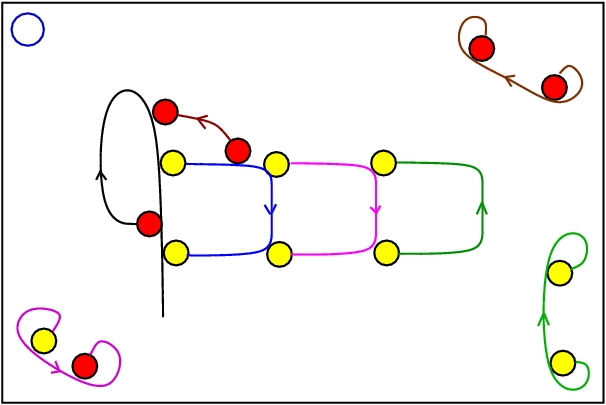Can we build everything from money (minted tokens)?
Can we build private computing systems, which are ἄπαξ χέων, which means "poured only once"?
As explained first in
Buliga, Marius (2018): Chemlambda strings. figshare. Journal contribution. https://doi.org/10.6084/m9.figshare.5751318.v1
then in
M. Buliga, Artificial life properties of directed interaction combinators vs. chemlambda. https://arxiv.org/abs/2005.06060
it is possible to express a graph rewrite as a chemical reaction of the form
(LEFT PATTERN) + (TOKEN_1) + (ENZYME) = (RIGHT PATTERN) + (TOKEN_2) + (ENZYME)
Here the tokens are small graphs from a pre-defined family. They are used to have a conservative chemical reaction. In the presence of tokens the graph rewrite appears as a permutation of the half-edges of the graph pattern.
As an illustration see this hand made animation of the 9-quine
We can see the tokens as a form of money bricks which are used for universal computation. Verbatim, each program is a graph "made of money" and the (decentralized) execution of the program is a process of money (tokens) exchanges.
As this is one of the chemlambda projects
https://chemlambda.github.io/index.html
the relation with chemlambda comes from the problem of naming links in chemlambda graphs (molecules). Minted tokens are a solution for this problem.
We treat in a unitary way a large family of asynchronous graph rewriting automata, by encoding a graph rewrite as a permutation of the ends of the edges of a graph. A local rewrite, i.e. one which involves a small number of nodes and edges, is then encoded as a small permutation.
By varying the permutation we can vary the graph rewrite. As an example, there are 14400 variants of the iconic beta rewrite: https://mbuliga.github.io/hapax/betarand.html
- Chemlambda and hapax: https://mbuliga.github.io/hapax/chemlambda-and-hapax.html
explains the mol notation and the encoding of graph rewrites as permutations; discusses differences from chemlambda
-
Ackermann(2,2) with hapax: https://mbuliga.github.io/hapax/hapax-ack.html
-
9_quine with hapax: https://mbuliga.github.io/hapax/hapax-9quine.html
two pages which use the js library
-
slides: http://imar.ro/~mbuliga/genchem.html
a presentation of the general ideas, towards the end relevant to hapax
-
the folder chemlambda: https://github.com/mbuliga/hapax/tree/master/chemlambda
contains the essentials of chemlambda-v2, which is used as an example with hapax
